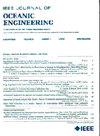修正多波束测深数据中杠杆臂误差引起的船道正交水深波动
IF 3.8
2区 工程技术
Q1 ENGINEERING, CIVIL
引用次数: 0
摘要
多波束回声测深系统已成为一种标准的声学遥感方法,广泛应用于海洋测绘任务。升沉传感器与传感器之间的杠杆臂由于变形或测量错误而产生的误差将表现为航迹正交水深波动,从而影响高分辨率海底地形图的准确表达。针对这一问题,本文分析了杠杆臂误差的特点及其与其他误差的区别,提出了一种新的杠杆臂误差标定方法。首先,采用双向差分法和多重启动算法提取杠杆臂误差引起的异常波动的周期模式;然后,建立校正模型,采用带移动窗口的随机样本一致性算法获得校正水深;最后,利用支持向量回归计算了杠杆臂误差随修正深度和初始深度的变化。结果表明,该方法能有效消除多波束测深中由于杠杆臂误差引起的船径正交水深波动,在复杂的海底地形条件下具有较强的鲁棒性。本文章由计算机程序翻译,如有差异,请以英文原文为准。
Correcting Ship-Track Orthogonal Bathymetric Undulations Induced by Lever Arm Errors in Multibeam Echosounder Bathymetric Data
Multibeam echosounder systems have been becoming a standard acoustic remote sensing approach and are widely applied in ocean mapping tasks. The errors of lever arm between heave sensor and transducer due to deformation or mistaken measurement will be manifested as ship-track orthogonal bathymetric undulations, which will hinder the accurate expression of high-resolution seafloor topographic maps. To address this issue, in this article, the characteristics of lever arm errors and the distinction from other errors are analyzed, and a new method is proposed to calibrate the lever arm errors. First, the periodical pattern of abnormal undulations caused by lever arm errors is extracted by the Two-Way Difference Method and Multistart Algorithm. Then, the correction model is established and the Random Sample Consensus Algorithm with moving windows is used to obtain the correction water depth. Finally, support vector regression is used to calculate the lever arm errors with the correction depth and initial depth. The results indicate that the proposed method can significantly eliminate ship-track orthogonal bathymetric undulations in multibeam bathymetry caused by lever arm errors and is robust in complex seabed topography.
求助全文
通过发布文献求助,成功后即可免费获取论文全文。
去求助
来源期刊

IEEE Journal of Oceanic Engineering
工程技术-工程:大洋
CiteScore
9.60
自引率
12.20%
发文量
86
审稿时长
12 months
期刊介绍:
The IEEE Journal of Oceanic Engineering (ISSN 0364-9059) is the online-only quarterly publication of the IEEE Oceanic Engineering Society (IEEE OES). The scope of the Journal is the field of interest of the IEEE OES, which encompasses all aspects of science, engineering, and technology that address research, development, and operations pertaining to all bodies of water. This includes the creation of new capabilities and technologies from concept design through prototypes, testing, and operational systems to sense, explore, understand, develop, use, and responsibly manage natural resources.
 求助内容:
求助内容: 应助结果提醒方式:
应助结果提醒方式:


